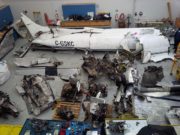News, Flight Deck, Safety Recommendation
CASA Tells Airlines to Decide Future of “Two in the Cockpit” Practice
Intentional Germanwings crash had prompted the requirement.
Viewing 1 - 5 of 5 results
News, Flight Deck, Safety Recommendation
Intentional Germanwings crash had prompted the requirement.
by FSF Editorial Staff
News, Human Factors, Safety Regulation
The new rules were developed in the aftermath of the March 2015 crash of Germanwings…
by FSF Editorial Staff

Pilot in fatal accident had high blood-alcohol content.
by FSF Editorial Staff
News, Fitness for Duty, Aviation Medicine
The study was launched in the aftermath of Germanwings 9525.
by FSF Editorial Staff
News, Fitness for Duty, Safety Regulation
Proposed new rules prompted by Germanwings crash.
by FSF Editorial Staff
